A new feature that will appear from time to time, ‘What Could Have Been’ will look at movies that had a chance of being something special, but, due to script, production, budgetary, or any other type of issue, it does not reach its full potential. . . first up, Brian De Palma’s 2019 Danish (though English language) crime thriller Domino.
When it comes to Brian De Palma, you tend to fall into two camps. . . defender or trasher. I have long been a huge fan, so when you hear that he is finally filming a new movie some seven years after his last picture, it is cause for excitement. Though, soon after, rumblings were heard. . .problems with the producers, the budget, the script. . . making everyone, even ardent De Palma fanatics, a tad apprehensive.
Soon, the director was calling it a “horrible experience”, citing numerous delays. He shot the film for thirty days, but spent an additional seventy waiting in his hotel room due to “underfunding” – from what it sounds like, the money-men were spinning a web of lies more complex than one of De Palma’s own scripts – funnily enough, he even went so far as to state, “Domino is not my project, I did not write the script”. Furthermore, numerous people who worked on the set were not getting paid. . . never a pleasant experience for a veteran director.
So, when you sit down and watch Domino, which comes in just shy of ninety minutes, something feels very off – it never really comes close to what anyone would call a finished product. It is rushed, underdeveloped, sloppily plotted, and sometimes feels like scenes are missing. . . overall, a bit of a mess (some have said that there is an extended cut, though that has now been refuted), yet I would never go so far as giving it a 4.4 rating (which is what it currently holds on IMDb) or claim that it has no artistic value (as some critics have said).
For it is still Brian De Palma – and that name has always been equated with visual flair and striking set pieces. Featuring a pair of fantastic moments, the film introduces two cops, Christian (Nikolaj Coster-Waldau) and Lars (Søren Malling), and actually begins with a nice little joke revolving around food. Flash forward to when Lars comes to pick up Christian for their shift the next night (at 4 A.M.), and he is being delayed by a very lovely young lady. De Palma both lovingly and voyeuristically slow zooms in on the couple in the room (as Lars frequently knocks on the door). . . and we watch as the camera continues on to the man’s gun (which he has forgotten due to his fling’s distractive qualities) – a tense moment of foreboding.

Following this up with one of the two aforementioned set pieces, the duo are then sent to a domestic disturbance, having a run-in with cagey criminal Ezra Tarzi (Eriq Ebouaney). What follows is a sequence somewhat akin to the opening of Vertigo, and, in De Palma’s capable (and very Hitchcock-like hands), he develops several minutes of intensely focussed, visually entrancing and suspenseful onscreen action. Keen buffs of the filmmaker will immediately notice a fantastic split diopter shot (allowing both the foreground and background to be clear in the same instance) – a De Palma special. So, at least for this one sequence, score (from frequent collaborator Pino Donaggio), cinematography (from Pedro Almodóvar’s go-to director of photography José Luis Alcaine), pacing, and editing come together for a thing of beauty.
Less promise follows, for after Lars gets wounded during the above sequence, things get garbled. An underdeveloped terrorist plot revolving around revenge for Ezra (there is an excellent story hidden in there somewhere), a CIA spinoff which finds Joe Martin (Guy Pearce) using the thug to get what he wants, and the main story which finds Christian and new partner Alex (Carice van Houten – making for a nice Game of Thrones team-up) out for their own form of revenge, never really comes together to form anything special other than a very average narrative that leads to one final fantastical set piece.

Shot using another acclaimed De Palma staple (slow-mo), the climactic moments take place in an historic bullring in Spain. With a twisted version of Bolero blaring overtop (a band also plays in the stadium), its rhythmic backbeat is mesmeric, much like the visuals. Encompassing two engrossing locations, Alex follows a terrorist plot taking place within the sporting event while Christian finds himself atop a high-rise (tracking the masterminds of the planned attack – who have their own part to play). Juxtaposing the former with the earthy browns and reds of the stadium (and the bustling energy of a gargantuan crowd) and the latter with the deathly cold neon blue of an advertising sign, we bounce back and forth, time standing almost still as De Palma slows the pace while our heartbeats rev up. His use of perspective (including through binoculars and by way of drone) is spot on, the timing of each person’s viewpoint cut together with pinpoint precision. It is what all set pieces should strive for – visual excellence.
A compromised film, Domino is by no means a masterpiece from one of America’s great directors, but it does feature a few flashes of the magic that Brian De Palma has brought to the big screen throughout the years. If you are a fan, you will definitely want to check it out, if not, this will only give you more fodder to add to your complaint list. If you fall somewhere in-between, it is not as bad as some have said, but it is by no means great – it is a movie, rather, of moments. Perhaps it may best be described as a pair of ornate, antique bookends that hold rag magazines. . . with a classically strong start and ending, it is very much filler in the middle (with only hints of some of his favourite themes, like the voyeur and obsession). I don’t want to continue to drone on, so I’ll leave it in your capable hands as to whether you believe in the flair of the matador. . . or if it all comes out as bull.

